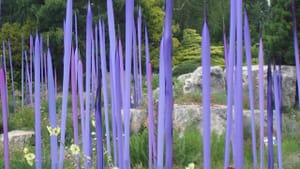Stay in the Loop
BSR publishes on a weekly schedule, with an email newsletter every Wednesday and Thursday morning. There’s no paywall, and subscribing is always free.
Nature and the art of nature
An art-lover's road trip from Colorado to Indiana

A friend of mine who left Philadelphia some years ago for graduate school in Boulder, Colorado likes to remark that even the homeless in Boulder are happy.
The whole of north-central Colorado is paradisaical for those drawn to mountains. I’m just home from several weeks at the Shambhala Mountain Center, located north of Boulder at an elevation of 8,000 feet, where I staffed a meditation retreat. The terrain is wild with flowers and sagebrush and surrounded by rugged peaks. Near one such rocky top called Marpa Point, a hiker may come upon two polished granite sculptures marking the interred ashes of poet Allen Ginsberg and his partner Peter Orlovsky. Ginsburg was an artistic associate of the Tibetan meditation master Chögyam Trungpa, who founded the Shambhala Mountain Center as well as the Naropa Institute (now Naropa University), where Ginsburg taught poetics.
Shambhala Mountain is home to the Great Stupa of Dharmakaya, a wonder of sacred Buddhist architecture in the Americas, ascending to 108 feet and housing a massive clay sculpture of the Buddha, painted gold and draped in rust-brown fabric, seated in lotus posture, hands forming the teaching mudra, with luminous eyes and a smile defining the word "gentle."
The terrain of Shambhala Mountain is awake with rabbits, chipmunks, squirrels, groundhogs, prairie dogs, deer, and noisy magpies. No one harms the animals or comes to shoot them. No one aims to capture and domesticate the animals or romanticize them into pets. The animals are sleek and unafraid. They don’t hide or run away. The little ones will scamper into a hole in the ground, but that seems more like instinct than anxiety. There are also moose, which I didn’t so much desire to encounter, and — just this year — river otter have claimed residence. It’s wonderful to discover that a place on Earth inhabited by humans can be unsentimentally (un-Disneyfied) Edenic.
Getting down to contrasts
Coming down from Shambhala to the more than mile-high city of Boulder, I attended the Colorado Shakespeare Festival, where Henry IV Part 1 is enjoying a splendid showing. There onstage is the counterpoint to a harmonious life — several noblemen of 14th-century England are in conflict with King Henry IV, questioning the legitimacy of his title. They are restless and eager to battle for power, preeminence, and, fundamentally, the right to be king. A peak moment arises in the play when war can be averted, but subterfuge intervenes; as a result, we lose the great Shakespearean warrior Hotspur, who in this production is furthermore an alluringly sexy husband. What happens is that, in an outreach of amnesty toward the rebels, King Henry offers to hear Hotspur’s grievances. But the “noble” men fomenting the uprising don’t convey King Henry’s message to Hotspur. They want their rebellion to go forward with Hotspur in the lead. And so Hotspur fights and Hotspur dies, a sacrifice to political mendacity. The play is a timely reminder of how a warrior who could prevent war may be manipulated by politicians to promote war.
After traveling south for an hour, I entered a fabricated urban oasis, the Denver Botanic Gardens, where an exhibit of glass sculpture by Dale Chihuly is installed through November. It’s a fantasy landscape that Chihuly has created! Fiery red, cobalt blue, or delicate lavender glass pillars, spikes, and spires reach beyond the tips of stately flowering plants, teeming grasses, or sapling trees. Convolutions of yellow or orange curlicues sprawl on the ground among arrays of low-lying flowers. All is brilliant color, as if seen through the eyes of mescaline. The sculptures may be apprehended at night via illumination, or by daylight, as on the bright, sunny morning that I visited. To experience a Chihuly masterwork closer to home, there is his towering Flame of Liberty at Philadelphia’s Liberty Museum.
From Denver eastward, the topography of Colorado lacks mountains and presents hardly a hill. One crosses into Kansas and the earth rises up a smidgen, rolling along for a bit, and soon levels out for mile upon mile, with acre after acre of green plants on one side of the road and yellows grasses on the other, bringing to mind “amber waves of grain.” People decry the flatness of Kansas, as I once did. But ever since a trip to Scotland in the early 1980s, I’ve altered my perception. There, at a cocktail party at the University of Glasgow, I complained of the redundantly sunless sky, to which a literature professor responded: “You haven’t learned to appreciate the subtlety in shades of gray.” It’s the same with Kansas: There’s aesthetic validity in learning to appreciate the variety of ripples in the earth.
Reclaimed prairie
I stopped in Indianapolis to visit my sister Gloria. She took me to walk the curving pathways of a reclaimed prairie space, created and tended by the green citizens of the Indiana town of Carmel. My sister told of how the prairie blooms and blooms and reblooms: Brown-eyed Susans burn out and up pop golden sunflowers. The prairie carries on, from spring into winter. Why ever did we let the prairie die, or the forest, or the woods, or the animals? To be in these natural places brings sanity.
 Then to experience the art of nature, my sister and I went to see a retrospective of Ansel Adams photography at the Eiteljorg Museum of American Indians and Western Art in downtown Indianapolis. The curator of the exhibit heralds Adams as “an artist of evanescent moments (who) gave us an earth very much alive.” (In such an instance, it’s nice to recall Philadelphia's impact on the art world's recognition of Adams: In the 1960s, the Kenmore Gallery in Philadelphia, which initially considered photos unworthy of exhibit alongside fine paintings, decided to show Adams's images.)
Then to experience the art of nature, my sister and I went to see a retrospective of Ansel Adams photography at the Eiteljorg Museum of American Indians and Western Art in downtown Indianapolis. The curator of the exhibit heralds Adams as “an artist of evanescent moments (who) gave us an earth very much alive.” (In such an instance, it’s nice to recall Philadelphia's impact on the art world's recognition of Adams: In the 1960s, the Kenmore Gallery in Philadelphia, which initially considered photos unworthy of exhibit alongside fine paintings, decided to show Adams's images.)
The Indianapolis exhibit takes us through his entire career, from Adams's early work in the 1920s before he knew he was an artist; to his 1940s time of photographing the national parks, including the Tetons, Old Faithful at Yellowstone, and Denali; and up to a 1956 image taken on the Hawaiian island of Maui that I’d not seen before. It is a close-up of Buddhist grave-markers, and in the background, a rainbow arcs the horizon. The photo is of course black and white, but one feels color in the sky.
Those who were there during the cremation of Chögyam Trungpa’s body at Karmê Chöling Retreat Center in northern Vermont remember the arising of rainbows. My friend Larry Mermelstein attested, “There were circular rainbows around the sun in a cloudless sky.” In Buddhism it is known that rainbows do indeed appear upon extraordinary events, such as the passing of a great being.
For more of Joanna Rotté's road trips, click here for one in West Virginia and Ohio and here for a James Garfield-themed trip.
Sign up for our newsletter
All of the week's new articles, all in one place. Sign up for the free weekly BSR newsletters, and don't miss a conversation.

 Joanna Rotté
Joanna Rotté